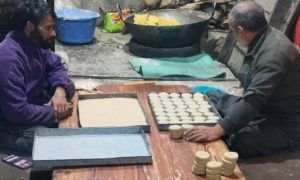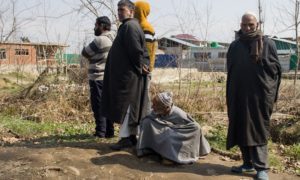As virtual reality is redefining the vibes of the valley, old pockets are becoming graveyards of the games they once played with a community spirit. These shifting sands are now making a native nostalgic about her halcyon days.
In the post-90 defiant drift—sending dozens of downtowners to different parts of Srinagar for spacious and solaceful shelters—Iram Sultan’s arrival in an urban wetland-cum-hinterland created an immediate identity crisis. For the discord-dented community of Kashmir, the heterogenous neighbourhood of Bemina acted as an oasis in the middle of a blistering desert. In this melting pot, the inmates either fleeing their haunting home-towns or conflict identities got some respite from fatal tags and labels.
Not many knew their new neighbours in this civil confinement that mostly acted as a flood sponge of the city throughout its deluged history. New inhabitants largely adopted a high-walled-withdrawn lifestyle. The old Srinagar’s vibrancy was missing in this new cluster despite housing a large chunk of city dwellers. This didn’t go well with Iram, who eventually decided to become a cultural pilgrim of her birth-burg.
Making rounds of her hometown to relive her ‘playful’ past, the history scholar often stops at an abandoned structure turned “ghost house”. She clears cobwebs from the rundown residence once housing a happy family torn apart by strife. “This is where we used to play our childhood games we lost to the brutal transition,” Iram, a jovial woman in her mid-thirties, says. “These old homes are now being denounced as ghettoes, but they were once playful homes.”
Iram walks up to the old mulberry tree planted in the backyard of the house. This is where, she recalls, her girl group would gather in the late afternoons for tip-toe. The lines they used to draw on the greyish mud surface stand blurred with time, so does the collective consciousness for the traditional sport. “As a mother of two,” Iram says, “I narrate stories of my childhood plays to my kids who sadly have become addicted to screens. Our kids need to know that our street-smart games helped us come of age.”
For Iram’s generation growing up in the troubled timeline of the nineties, street games had become a resilient act. As situational offensive almost crippled civilian life with curfews and crackdowns, these community plays became a sign of life amid lifelessness. They would drive out the desolation in alleys, lanes and by-lanes of down-town. “At times,” continues Iram, as she touches the time-worn trunk of the old mulberry tree, “we used to run for our lives upon shelling.”
Besides their unfinished game, they used to leave behind their sneakers scattered across the courtyard. “Such was life for many of us,” Iram recalls with a tinge of sadness in her voice. “We were living and playing dangerously.”

[FPK Photo/Amir Bin Rafi.]
In his down-town dwelling nested at the foothills of the Kohi-e-Maran, Kashmir’s noted chronicler Zareef Ahmad Zareef calls the old city as an active arena of some larger-than-life games. Sporting his signature karakul cap and neatly-trimmed beard, Zareef defines these games a normalcy life-cycle for Kashmiris. “Unlike the screen games now,” he says, “those games would make our children realistic and robust.”
Among those games played in the old city of yore was Tule’langun. Young girls would gather in their neighbourhood parks or playfields and take turns to lift each other on their back and play a literal seesaw. Upon lifting, a player would chant, “Tule’langun?” The other would reply: “Tulaan chas…” The play would instil a sense of collective work-sharing spirit and make kids aware of life’s precarious reality.

[FPK Photo/Amir Bin Rafi.]
Some of these games would also make these kids nimble-footed. In Tcour Kaar, the kids would scream and create a melee. It was a mock drill of catching thieves on the spur of the moment. “The kid acting as a thief would be then produced before cops and a judge being played by other children,” Zareef says. “The play would itself make kids conscious of roles and laws governing the society.”
One of these plays played in the old city circuit was Zang Taar. The play of rope-and-cross would strengthen reflexes in children. But among all these games, Iram misses Hikkat—huddle—the most.
As a preteen, she would arrive in the abandoned house of her hometown and participate in the play. But 25 years later, the deadly silence has overtaken the courtyard that once resonated with lively voices and vibes. Most of her childhood friends have long left the place. Many old structures are now housing new inmates.
But amid these shifting sands, Iram continues to visit her birthplace as a cultural pilgrim. “I know, I’m not the only one,” she says about her old city ode. “There are many cultural pilgrims like me who often return to their roots to feel some playful past.”










